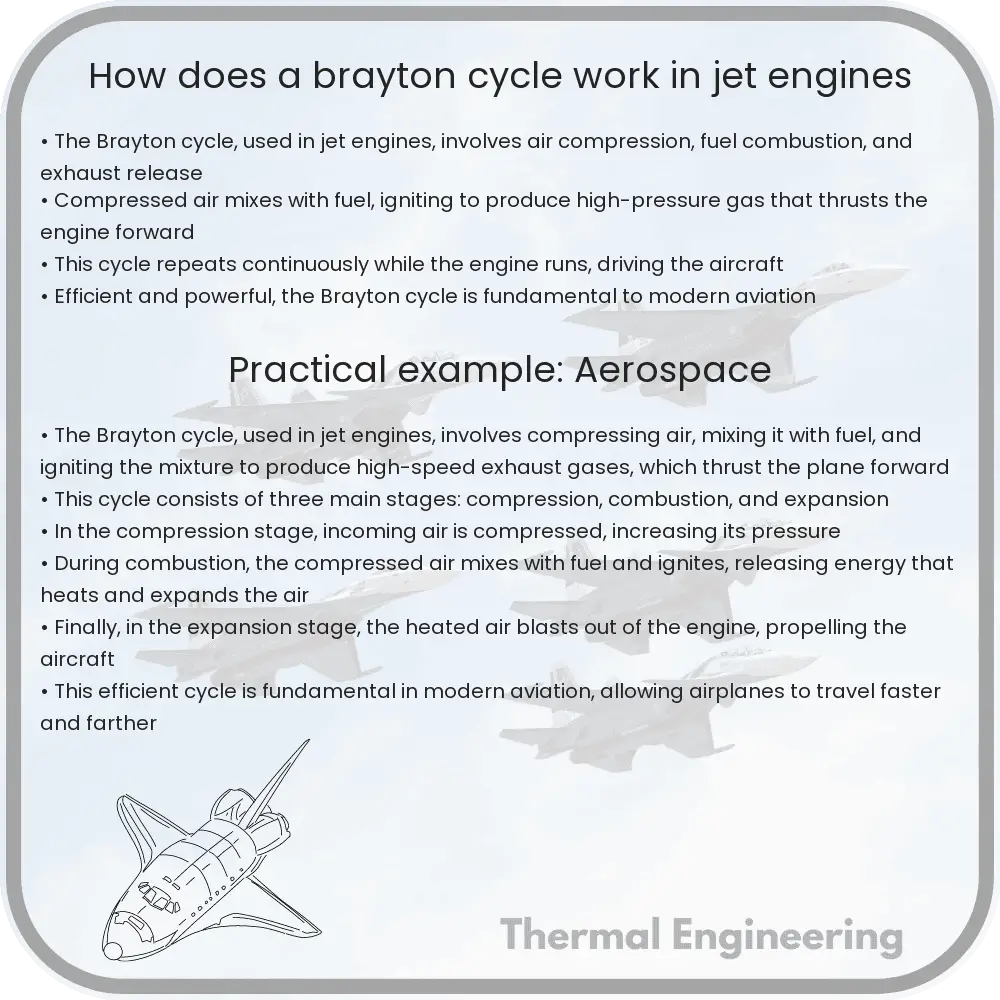Learn about the Brayton cycle, a key thermodynamic process in jet engines, involving air compression, fuel combustion, and gas expansion.

Understanding the Brayton Cycle in Jet Engines
The Brayton cycle, also known as the gas turbine cycle, is the fundamental thermodynamic process that powers modern jet engines. Understanding how this cycle operates provides insights into the principles of jet propulsion and the engineering behind aircraft engines. The cycle involves the conversion of air and fuel into energy through a series of steps characterized by compressing, heating, and expanding gas.
Components of the Brayton Cycle
The Brayton cycle consists of three main components:
- Compressor: This component draws in air from the atmosphere and compresses it, raising its pressure and temperature. Compression is typically accomplished through a series of rotating blades.
- Combustor: The high-pressure air from the compressor mixes with fuel (usually aviation kerosene) and is ignited. The resulting high-temperature, high-pressure gas expands forcefully.
- Turbine: The hot gases then pass through a turbine, where the energy from the expanding gases is used to power the compressor as well as produce useful work, such as thrust in a jet engine.
Thermodynamic Phases of the Brayton Cycle
The Brayton cycle can be broken down into four essential phases:
- Isentropic Compression: Air is compressed in the compressor, increasing its pressure and temperature while assuming no heat loss to the surroundings (isentropic process).
- Constant Pressure Heat Addition: Fuel is added in the combustion chamber and ignited. The high-pressure combustion generates a significant increase in the temperature of the gas.
- Isentropic Expansion: The high-temperature, high-pressure gas expands through the turbine, decreasing its temperature and pressure while performing work.
- Constant Pressure Heat Rejection: In a simple cycle, this phase can be considered as the exhaust phase where the gas returns to the atmospheric pressure releasing excess heat.
Each stage of the cycle is keyed to maximizing efficiency and output, leveraging the properties of gas dynamics and thermodynamics.
Efficiency and Performance
The efficiency of a jet engine operating on the Brayton cycle depends on the pressure ratio (the ratio of the compressor exit pressure to the inlet pressure) and the turbine inlet temperature. Higher pressure ratios and higher temperatures generally yield greater efficiencies and more power output.
However, there are practical limits: materials must withstand high temperatures and pressures, and engineering solutions must carefully balance between performance, reliability, and cost.
Applications and Innovations
While the Brayton cycle is primarily associated with jet engines, it also finds applications in other areas such as in gas turbines for power generation. The principles learned from jet engine designs are helping engineers to develop more efficient and cleaner power plants.
Innovations continue in materials science and aerothermal engineering, pushing the boundaries of what is possible in terms of engine temperatures and pressures, thus improving the overall efficiency and environmental footprint of jet engines.
Understanding the Brayton cycle is crucial for anyone interested in the fields of aerodynamics, propulsion, and thermal power systems. This cycle not only drives a significant part of modern transportation but also continues to inspire advancements in thermodynamic applications.